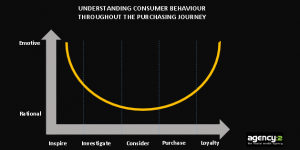May 27, 2016
Making social ad performance and social marketing impactful by understanding consumer behaviour
Smartphones are walking billboards
We all know how quickly and comprehensively social media has changed the marketing landscape; traditional marketing is no longer the bread and butter of any given strategy. There are endless ways to reach new customers, with so many new tools presenting fresh challenges to understanding consumer behaviour.
In order to effectively influence consumers,
Content must:
- hit the right buttons emotionally
- be effective at promoting conversions
- encourage engagement
- be delivered at the right time
Customers must:
- Trust the brand
- Feel connected to the brand and their messaging
- Be compelled to join the community
- Feel socially connected
How do we effectively reach customers when they are being bombarded with information every minute of every day?
1) IDENTIFY WHERE THEY ARE WITHIN THE PURCHASING CYCLE
- Within the purchasing process, there are many stages where different decisions will be made. In order to fully understand consumer decision making, we feel it is essential to know where a consumer is within the buying cycle. Once this is identified, the content channels and the creative can be targeted to reach these various stages.
- As can be seen here, in order to push forward purchasing intent, the emotional brain must be stimulated both at the beginning of the buying cycle as well as at the end, once a purchase has been made. The rationale behind this is to funnel the purchase through the competitive noise, by inspiring brand affinity and purchasing desire. The rational brain comes much more into play once a consumer is already on their purchasing journey.
2) IDENTIFY THE LEVEL OF BRAND AFFINITY
This will run along a gradient, from new customer to loyal or repeat customer. It is necessary to figure out where a consumer stands with respect to their ‘feelings’ about a brand.
3) IDENTIFY THE MOTIVATION BEHIND THE PURCHASE
- The complexity of the product cannot be forgotten, as this will feature in research around competitiveness and appealing to a consumer’s emotional side.
- For example, let’s look at a parent purchasing a cot mattress vs. a toy storage box. In the first instance, brand trust is a huge component whereas in the latter example, the product benefits and specification will be much more relevant.
- In both examples, trust and product benefit both feature but in differing proportions based on purchasing intent.
Understanding the above consumer behaviours will help shape your social media strategy and drive purchasing through increased engagement and clever influencing of behaviour personalisation. In turn, brand advocacy will be increased without much effort!


Comments